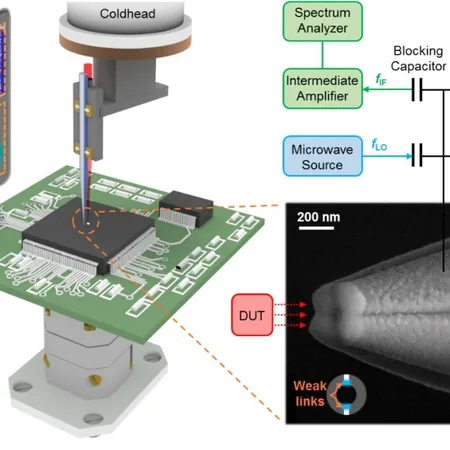
Revolutionizing Microwave Technology: The Breakthrough in Josephson Microscopy
2025-03-31
Author: Mei
In the rapidly advancing realm of microwave technology, which underpins essential innovations in high-frequency integrated circuits, quantum computing, and microwave photonics, having precise tools for measurement and imaging is paramount. As the need arises to optimize the performance of microwave devices, researchers have been focused on refining methods to detect spatially resolved microwave properties. This is crucial to address challenges such as electromagnetic compatibility and signal crosstalk, while promoting efficient signal coupling.
Current Microwave Imaging Techniques
While several microwave imaging techniques such as scanning near-field microwave microscopy (SNMM) and nitrogen-vacancy (NV) centre microscopy have been introduced, they often struggle to strike a balance between sensitivity, resolution, and bias magnetic fields. However, the introduction of the Josephson junction—a fundamental component in superconducting electronics—could be a game changer. Comprising two superconductors separated by a barrier layer, Josephson junctions showcase unique non-linear properties that allow them to act as high-sensitivity mixers for microwaves, approaching the quantum noise limit.
Nanoscale Josephson Junctions
When subjected to microwave frequencies surpassing their characteristic frequency, these junctions can function as bolometers, capable of detecting single microwave photons. This innovation has paved the way for the development of nanoscale Josephson junctions, which represent a breakthrough in near-field microwave detection and imaging capabilities.
Advancements from Professor Peiheng Wu's Team
A groundbreaking development has emerged from a team led by Professor Peiheng Wu of the Research Institute of Superconductor Electronics at Nanjing University, China. They have unveiled a state-of-the-art superconducting Josephson probe microscope, specialized in near-field microwave spectroscopic imaging. This advanced microscope marries the exceptional sensitivity of Josephson junctions with the high spatial resolution characteristics of scanning probe microscopy.
Unique Features of the Josephson Probe Microscope
What sets the Josephson probe microscope apart is its ultra-broadband capability, coupled with high sensitivity and resolution for electromagnetic characterization of microwave chips across a frequency spectrum that spans from traditional microwave ranges to millimeter waves. This tool is capable of providing detailed insights, including intensity measurements, spectral analysis, and frequency-selective imaging.
Implications for Future Research
As the excitement around this new technology builds, it is anticipated that the Josephson probe microscope will make significant contributions to ongoing research in high-frequency integrated circuits, quantum computing, and even emerging fields such as magnonics.
Innovative Probe Development
The core innovation of this microscope lies in the development of the Josephson probe itself. Fabricated using weak-link Josephson junctions on a nanoscale quartz tip, this probe was produced through a sophisticated process involving intricate grooved quartz tube drawing and multi-angle evaporation, thereby overcoming the limitations of traditional methods such as magnetron sputtering. Remarkably, the research team demonstrated the presence of clear Shapiro steps under microwave irradiation from their nanoscale Josephson probe, validating its superconducting properties.
High Sensitivity and Coherent Detection
Further tests revealed that this probe features high microwave sensitivity based on its response characteristics, and its ultra-broadband coherent detection by harnessing the Josephson probe's substantial nonlinearity. Researchers noted this allows for the precise measurement of unknown microwave signals, with frequency resolution levels in the kHz range across a frequency span of 1 GHz to 200 GHz.
Sophisticated Near-Field Microscope System
Implementing this technology, the research group assembled a sophisticated near-field microscope system capable of resolving spatially detailed microwave images. They successfully identified standing waves in coplanar waveguides and mapped ring-shaped microwave distributions within voltage-controlled oscillator chips. Impressively, the spatial resolution attained by this microscope reaches sub-micrometer levels, with avenues for enhancing performance in the future.
Low-Temperature Applications
Ideal for low-temperature environments, this Josephson probe microscope emerges as a non-destructive imaging solution critical for ultra-low-temperature quantum technologies.
Publication and Contributors
The findings from this exciting research have been documented in the latest 2024 issue of National Science Review, with Dr. Ping Zhang taking the lead as the principal author. Collaborating with him are Dr. Yang-Yang Lyu, Professor Yong-Lei Wang, and Professor Huabing Wang, co-corresponding authors on this noteworthy work that is set to redefine microwave technology landscape.
Stay tuned as we continue to explore the breakthroughs that Josephson microscopy can bring to the forefront of technological advancements!



 Brasil (PT)
Brasil (PT)
 Canada (EN)
Canada (EN)
 Chile (ES)
Chile (ES)
 Česko (CS)
Česko (CS)
 대한민국 (KO)
대한민국 (KO)
 España (ES)
España (ES)
 France (FR)
France (FR)
 Hong Kong (EN)
Hong Kong (EN)
 Italia (IT)
Italia (IT)
 日本 (JA)
日本 (JA)
 Magyarország (HU)
Magyarország (HU)
 Norge (NO)
Norge (NO)
 Polska (PL)
Polska (PL)
 Schweiz (DE)
Schweiz (DE)
 Singapore (EN)
Singapore (EN)
 Sverige (SV)
Sverige (SV)
 Suomi (FI)
Suomi (FI)
 Türkiye (TR)
Türkiye (TR)
 الإمارات العربية المتحدة (AR)
الإمارات العربية المتحدة (AR)